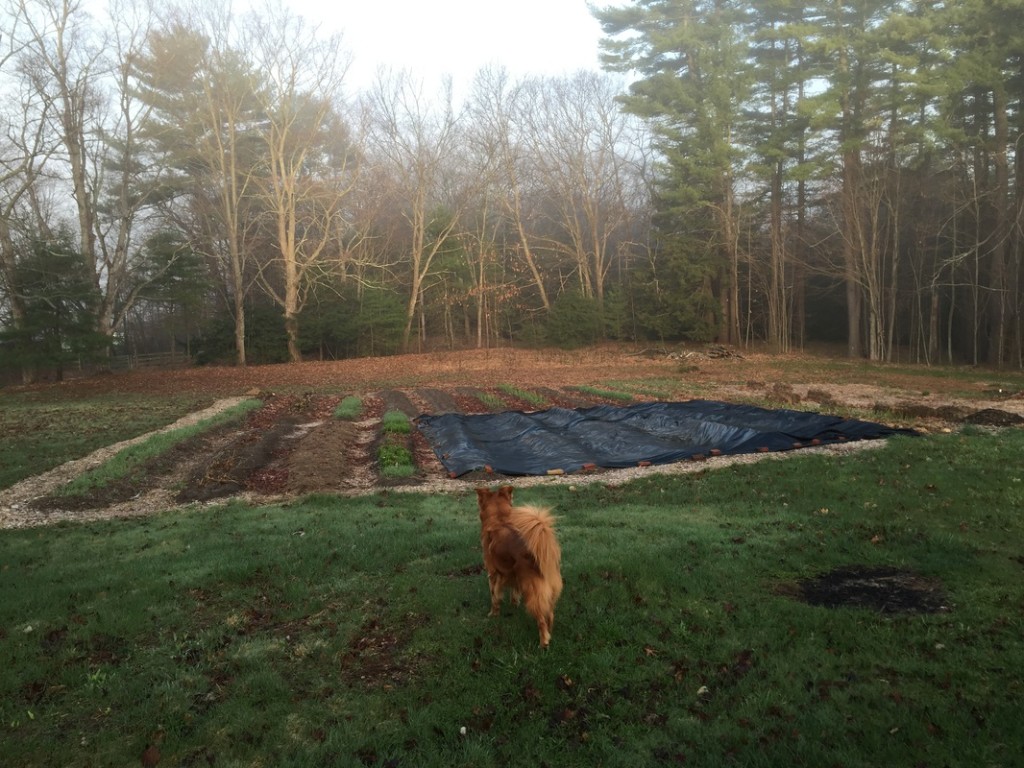It’s been so long! I apologize for my hiatus from this blog. I’m going to skip the chit chat and get right to the topic though: TARPS.
I know a lot of small-scale growers have been using tarps as a critical component of weed control in their systems and to facilitate minimum tillage organic production. Some folks call this practice “occultation.” There’s a bit of information online, including some great blog posts from Bare Mountain Farm in Oregon and Spring Forth Farm in North Carolina. A reader also alerted me to some research in Quebec where tarps were applied to cover crops in late fall and then a no-till broccoli crop was transplanted in June.
And speaking of Canada, perhaps the biggest proponent of using tarps is Jean-Martin Fortier, author of The Market Gardener. Tarps are an integral part of his bed preparation and he leaves them on for 2-3 weeks to suppress weeds prior to planting crops.
Tarps or other light barriers can also be used after planting for weed control. Researchers in Maryland found that leaving a weed barrier cloth on a killed, high-residue cover crop for a couple of weeks can create nearly season-long weed suppression between rows in transplanted tomatoes. All told, the practice of occultation holds a lot of promise, but there’s huge variability in how people are implementing it. How long do you have to leave a tarp on at different times of the year to get good weed suppression and kill cover crops? Is a black tarp best or does clear plastic work? (like solarization).
Experimenting in New Hampshire
Early last fall, a sustainable agriculture undergraduate student at the University of New Hampshire contacted me. It was a lucky coincidence because I’m at UNH now, too. The long and the short of it is that a research project emerged and Seamus is currently getting an experiment underway to test just how long one needs to keep tarps on to kill a rye-vetch cover crop, whether there’s a difference between black plastic and clear plastic tarps, and what kind of weed suppression this system provides during the production of no-till cabbage this summer.
We’re hoping this will give us valuable information about how to optimize both cover crop growth and weed suppression. In other words, we want to be able to keep the tarp on just long enough to kill the cover crop and suppress weeds, but not so long that we lose out on much spring growth of the cover crop. We have joked that this experiment, unlike some experiments that happen on research farms (I plead guilty!), is very realistic… We didn’t get the cover crops in until mid-September, they were broadcast (not drilled), there are definitely weeds growing among the rye and vetch, and there’s no way this cover crop would provide enough residue/mulch for very good weed suppression without something additional. Obviously we’re hoping the tarps will provide that.
But we only have one site and we can only answer so many questions. We know many of you have experimented with tarps of various sorts and we’d love to get feedback to share on the blog along with our research results from this upcoming season. Photos are great, too!
Shoot me an email or respond in the “contact” form below if you’ve got some input on using tarps (nl1004@wildcats.unh.edu).
Where is your farm?
What kind of tarps did you use?
Were you trying to kill cover crops or just suppress weeds?
Did you mow/crimp/treat cover crops first?
When did you apply the tarp?
How long did you leave the tarp on?
How did it work?
Any other feedback?




